Can the "Bernanke Put" Lift Gold Sharply Higher?
Commodities / Gold & Silver Sep 06, 2007 - 01:11 AM GMTBy: Gary_Dorsch
“I only know of two men who really understand the true value of gold, an obscure clerk in the basement vault of the Banque de Paris and one of the directors of the Bank of England. Unfortunately, they disagree,” remarked Nathan Mayer Rothschild, the former owner and operator of England's Royal Mint Refinery, and the primary gold agent to the Bank of England in the early 1800's.
When the Bank of England's gold reserve was drained by the costs of the Napoleonic wars, down to 235,000 ounces (£1 million) against note issue liabilities of £15.5 million, it was Nathan who sent secret shipments of gold and silver to Wellington's army in Europe and financed the defeat of Napoleon. In 1825, it was Nathan who rescued the Bank of England and prevented the collapse of the entire British banking system, after a run on gold caused the collapse of 145 banks.
In 1919, the Bank of England, determined to restore London as the main gold market, reached an agreement with seven South African mining houses to ship their gold to London for refining, after which it would be sold through NM Rothschild at the best price obtainable, giving the London market and the Bullion Brokers a chance to bid.
The London Gold Fix was set at the London merchant bank NM Rothschild, from Sept 1919 until April 2004. NM Rothschild had profound influence at the London Bullion Market, where trading volume was 42 million ounces of gold per day (more than twice South Africa's annual gold production), including dealings in physical, leased, and forward sales.
 The Rothschild empire helped to establish and finance oil giant Royal Dutch Shell, cemented De Beer's control of the world's diamonds, and following World War II, invested in vast areas of resource rich properties in Canada, and in base metals giant Rio Tinto. Legend has it, that the Rothschild fortune measures in the trillions of dollars. Rothschild's huge stash of gold and natural resource shares is tailor made for the day when the public wakes up to the fraud of fiat currency.
The Rothschild empire helped to establish and finance oil giant Royal Dutch Shell, cemented De Beer's control of the world's diamonds, and following World War II, invested in vast areas of resource rich properties in Canada, and in base metals giant Rio Tinto. Legend has it, that the Rothschild fortune measures in the trillions of dollars. Rothschild's huge stash of gold and natural resource shares is tailor made for the day when the public wakes up to the fraud of fiat currency.
Nowadays, the clerks at Bank Paribas are working overtime, trying to determine the value of sub-prime US mortgage debt sitting in their vaults. European banks are afraid to lend money to each other, after two German banks nearly collapsed from the toxic US sub-prime slime. Eschewing a sense of responsibility, the Federal Reserve is expected to try and cover-up the mess, conjured-up and distributed by Wall Street brokers, by exercising the “Bernanke Put”, or lowering the federal funds rate and flooding the world with more US dollars.
London Gold “Closely Watching the Fed”
Gathered around a table in one of the Bank of England's grand meeting rooms, a select group of Britain's top gold traders could not believe what they heard. It was May 1999, and the gold price was stagnant around $275 /ounce, after a long and extended bear market. The UK's Treasury chief Gordon Brown had decided to sell 400 tons, or more than half of the country's centuries old gold reserves.
In a move that astonished dealers, Mr Brown insisted on selling the gold in open auctions. The first sale drove the price down to $254, the low-point of an 18-year slide. There were 17-auctions between July 1999 and March 2002 yielding an average of $275 an ounce. The proceeds were unwisely switched into 40% Euros, 40% US dollars, and 20% yen. Since March 2002, the US dollar has plunged 42% against the British pound, while the Japanese yen is 23% lower against sterling.
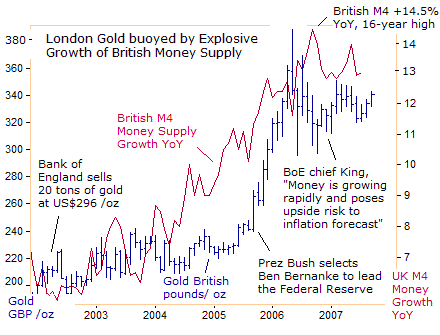
With gold now trading at $680 an ounce , Mr Brown's decision to break ranks with the US, Japan, France, and Germany by selling 400 tons of its gold, has cost UK taxpayers more than £2 billion. Then, moving further away from monetary discipline, the Bank of England oversaw the rapid expansion of the British M4 money supply, to 13% growth in July 2007, or double its growth rate in March 2002.
The rapid expansion of the British M4 money supply, to a 16-year high, is fueling house price inflation, running at a annual 12.8% in August, up from 10.3% in the previous month. “ Broad money is growing rapidly and that does pose an upside risk to the inflation forecast, so money certainly matters,” BoE chief Mervyn King confessed in Nov 2006. BoE hawk Andrew Sentance added on July 10 th , “The rapid pace of money growth is a warning signal we should pay attention to.”
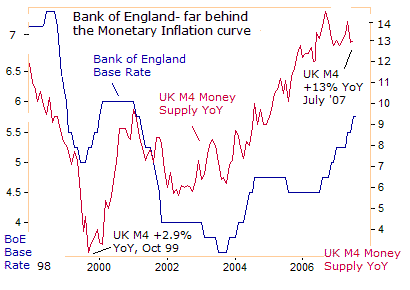
To regain some control of the UK's M4 money supply, the BoE hiked its base lending rate five times, or 125 basis points to 5.75%, to its highest since April 2001. The last rate hike occurred on July 5 th , “The margin of spare capacity in businesses appears limited, and most indicators of pricing pressure remain elevated. The balance of risks to the outlook for inflation in the medium term lies to the upside,” the BoE said.
The upside risks to UK inflation emanate from the double-digit growth of the British money supply. And while the BoE's baby-step rate hikes to 5.75% reined in M4 growth to 13% in July, it still leaves the central bank far behind the monetary inflation curve. In order to lower the growth rate of M4 into single digits, the BoE would probably need to lift is base rate another 75 basis points to 6.50 percent.
But newly installed UK prime-minister Gordon Brown, argues there is little point using money supply targets to control inflation since the relationship is not stable. “Rigid monetary rules that assume a fixed relationship between money and inflation do not produce reliable targets or policy,” he said on June 10 th .
BoE rate Hike Trumped by the “Bernanke Put”
The turf war over a quarter-point rate hike to 6%, between Mr Brown and Threadneedle Street came to an abrupt halt on August 17 th , when the Federal Reserve decided in a hastily arranged meeting to exercise the “Bernanke Put.” In an about face, the Fed lowered its discount rate by a half-point to 5.75%, and implied it would do whatever it takes, to prevent the financial markets from tumbling.
On August 21 st , Fed chief Bernanke told Senate Banking Committee Chairman Christopher Dodd, that he was willing to use all the tools available to him, to calm turbulent financial markets. Then on Sept 1 st , Bernanke told a gathering of the world's top central bankers at Jackson Hole, Wyoming, “The Federal Reserve stands ready to take additional actions as needed to provide liquidity and promote the orderly functioning of markets” he said, hinting at lower rates.
Over the past decade, a pattern has emerged in the US financial markets. Every time there has been a financial crisis, the Fed has opened the money spigots and poured liquidity into the stock market to mute the impact on the real economy. The “Greenspan put” was a bet that “Easy” Al would respond instinctively to financial crises by lowering short-term interest rates. Greenspan's response to the bursting of the dotcom bubble was to slash the fed funds rate to less than zero percent in inflation adjusted terms for more than a year.
Now, Chicago futures traders are pricing in 75 basis points of Fed rate cuts to 4.50% by year's end, starting with a quarter-point cut on Sept 18 th , to ease the pain of Wall Street banks and brokers from the sub-prime mortgage slime. Most interesting, the upcoming exercise of the “Bernanke Put” is expected to begin at a time of elevated inflation pressures, high oil prices, and a weak US dollar.
”Although the downside risks to growth have increased somewhat, the FOMC's predominant policy concern remains the risk that inflation will fail to moderate as expected. Moreover, the high level of resource utilization has the potential to sustain those pressures,” the Fed indicated just a month ago.
The exercise of the “Bernanke Put” is putting a monkey wrench in the BoE's plan to hike its base lending rate to 6 percent. Other central banks in Australia, Canada, the Euro zone, and Korea also find themselves in the same predicament - unable to lift short-term interest rates to control explosive money supply growth. Hiking interest rates overseas, while the Fed is lowering its rates in the US, could grease the skids under the US dollar, knocking it into a violent free-fall.
Like most other central banks, the BoE is engaged in a game of competitive currency devaluation with the Bernanke Fed. The BoE tolerates 13% growth of its M4, to counter the Bernanke Fed, which is inflating the US M3 money supply at a 13% annualized rate. Now with the exercise of the “Bernanke Put” on the horizon, it's possible that the US M3 growth rate might accelerate into un-chartered territory of 15% or higher, to levels that might be associated with hyper-inflation.
Already, interest rate differentials have swung by 200 basis points in the British pound's favor over the US dollar, lifting sterling from $1.83 a year ago to $2.02 today. Exercising the “Bernanke Put” could lift the British pound even higher, which in turn, could persuade the BoE to put its rate hike campaign on ice, thus allowing double-digit M4 money supply growth to kindle higher UK inflation.
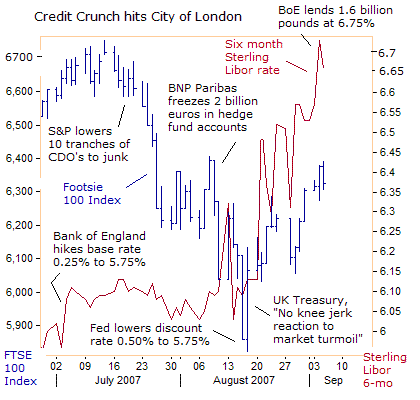
In a very interesting twist, while central banks in the Euro zone, the US, Japan, Canada and Australia have all intervened to boost liquidity in their money markets, the Bank of England has not injected emergency cash into the UK banking system. European banks are afraid to lend money to each other, fearing the other side is dangerously exposed to toxic sub-prime US mortgage debt.
BoE chief Mervyn King is reluctant to bail out banks that bought toxic US sub-prime slime. This means there is no “King Put” option, and interest rates in the UK Libor market have already undergone a quasi tightening. The six-month sterling Libor rate, jumped to 6.75% yesterday to its highest since 1998. T he gap between the BoE's 5.75% base rate, and the six-month sterling Libor rate, reached its widest point since the mid-1980's, indicating great uncertainty over the solvency of some banks.
On Sept 2, Bob Diamond, the chief executive of Barclays Capital, called for the BOE to inject greater liquidity into the UK money markets, to relieve some of the upward pressure on Libor rates. “For the recovery to continue we need to find more ways to get liquidity into the short end of the curve. That's down to confidence, and that's down to the central banks. We've seen thoughtful moves by the Fed and the ECB.”
Hind sight is the best sight, but if UK bankers could exchange their sub-prime slime for gold today, they would gladly jump at the opportunity. Instead, they pray for a BoE bailout. As Nathan Mayer Rothschild was fond of saying, “I care not what puppet is placed upon the throne of England to rule the Empire on which the sun never sets. The man that controls Britain's money supply controls the British Empire.”
European Rate Hikes Nearing an End
“The current cycle of Euro zone interest rate tightening is nearing its end,” said EU Monetary Affairs Commissioner Joaquin Almunia on Sept 3 rd . “The main part of the interest rate rise is already done. I don't think it is going to rise much more. In the very short term, rate cuts won't be announced but for sure, in the medium term, interest rates are going to fall because the Spanish, European, world economies are fundamentally solid,” he added.
Almunia is a mediator between the European Central Bank, which wants to push interest rates higher, and European politicians, led by France's Nicholas Sarkozy, who want the ECB to weaken the Euro currency. Almunia seems to be signaling a compromise between the two warring factions, allowing for one final ECB rate hike to 4.25%, but not immediately at the upcoming Sept 6 th meeting.
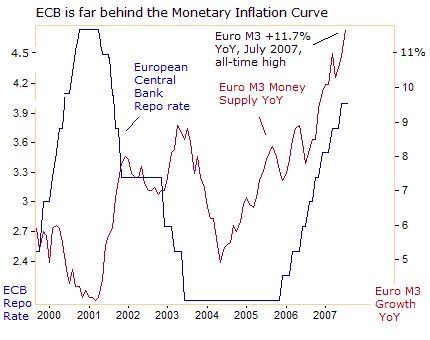
A peak in the ECB rate hike cycle at 4.25% would still leave the repo rate below its high-mark of 4.75% in 2000, when the central bank was targeting the Euro M3 growth rate at 4.50%. Today, under ECB chief Jean “Tricky” Trichet, the ECB is inflating the Euro M3 money supply at an explosive 11.7% annualized rate. In fact, Euro M3 is growing much faster today, than when the ECB began its baby-step rate hike campaign in December 2005.
The ECB lingers behind the monetary inflation curve, which provides a buoyant environment for gold. The ECB rate hike cycle has been derailed, because two German banks almost collapsed from their exposure to toxic US sub-prime mortgage debt last month. German lenders IKB and SachsenLB required emergency bailouts, and foreign banks are reluctant to lend to another bank WestLB. Bavarian state bank BayernLB said it also is infected by US sub-prime slime.

With the German inter-bank system in turmoil, Euro zone politicians are applying pressure for a steady monetary policy, worried that the “Bernanke Put” could drive the Euro sharply higher, even without the help of ECB rate hikes. A stronger Euro can act as a quasi tightening mechanism by shielding Euro zone importers from higher costs for crude oil and other raw materials.
The ECB is also under pressure to cut interest rates, at a time of out-of-control Euro M3 growth. “The ECB needs to restore confidence by giving the signal that it stands ready to defend growth and jobs by cutting interest rates if necessary,” the European Trade Union Confederation said on August 30 th . “To maintain robust growth and job prospects, the ECB needs to consider a timely cut in interest rates,” said Reiner Hoffmann, deputy of the ETUC.
Calls for a steady ECB policy are gaining the upper hand over the hawkish views of Greek central banker Nicholas Garangas who warned six-weeks ago, on July 17 th , “Risks to inflation have increased, and it is crucial that we act in a firm and timely manner, preemptively, to ensure price stability,” he said, citing higher oil prices and high capacity utilization as inflationary drivers.
Just a month ago, ECB chief Jean “Tricky” Trichet uttered the words, “strong vigilance,” signaling a tightening in Euro zone credit costs, after the central bank held rates steady at 4.00% on August 2 nd . “Strong vigilance is of the essence to insure that risks to price stability over the medium term do not materialize,” Trichet said. However, “When I use the word strong vigilance, don't forget we never pre-commit,” Tricky Trichet added, keeping his audience off balance.
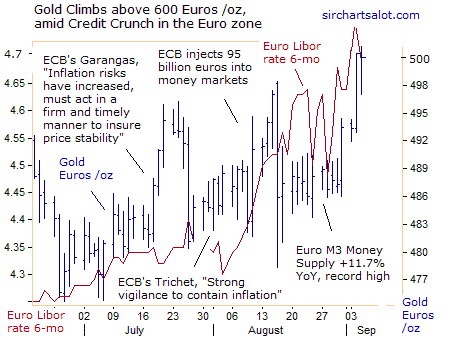
However, inflation psychology is bubbling in the Euro zone, with crude oil standing above $75 per barrel, and gold climbing above 500 euros /oz in Frankfurt. European gold bugs are itching to buy the yellow metal, with Trichet's “strong vigilance” rhetoric to contain the Euro M3 money supply dissipating into thin air. Gold traders will keep a close eye on “Tricky” Trichet's money pumping operations.
The ECB added temporary funds to money markets in a series of injections in August but has since withdrawn most of the surplus. That's put upward pressure on the six-month Euro Libor rate to as high as 4.75% this week, it's highest since 2001, and roughly 40-basis points higher than normal. It remains uncertain whether “Tricky” Trichet will countenance a de-facto tightening of the Euro Libor rate.
“Should this persist tomorrow, the ECB stands ready to contribute to orderly conditions in the Euro money market,” the central bank said on Sept 5 th . Amid all the stress and turmoil in the German banking system these days, gold is looking like a “safe haven,” immune to the toxic disease of sub-prime US mortgage slime.
Japanese Warlords fuel Global Inflation
Next to the “Bernanke Put,” the greatest source of global inflation is the infamous “yen carry” trade. According to the clerks at Bank Paribas, the size of the “yen carry” trade has mushroomed to about $1.2 trillion. It's estimated that hedge funds and speculators have borrowed close to $200 billion in yen, to trade futures and options contracts, at 8 to 10 times their margin requirements.
The Bank of Japan fuels global inflation via the “yen carry” trade, by pegging its overnight loan rate a 0.50%, far out of alignment with the rest of the planet. Tokyo's fuzzy math shows its consumer price index is locked at zero percent, which in turn provides political cover for the BoJ to fuel asset inflation worldwide. Tokyo argues that its economy has battled with deflation for seventeen years, yet Tokyo gold traders know the CPI numbers are phony, and bid gold 100% from three years ago.
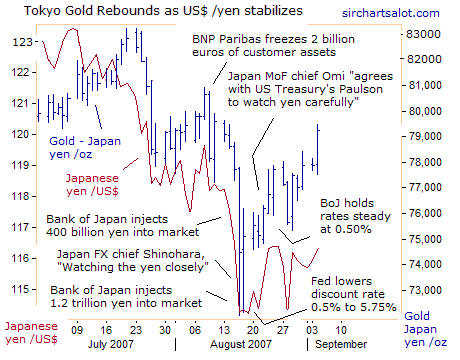
The brutal unwinding of “yen carry” trades in July-August, triggered contagion sales of Tokyo gold from a record 83,000-yen /oz to as low as 73,000-yen on August 17 th . However, massive injections of yen into the Tokyo money markets by the Bank of Japan, a half-point cut in the Fed's discount rate, and threats by Japan's financial warlords to intervene in the foreign exchange market to support the dollar, enabled Tokyo gold to regain its footing and eye record highs again.
On August 23 rd , BoJ chief Toshihiko Fukui hinted that the exercise of the “Bernanke Put” could put Japanese monetary policy on ice. “If the Fed were to take some kind of policy step in September, we will closely examine whether our views match those of the Fed. There's a possibility that US growth will be restrained. That's the point we need to watch. We do not have any preset schedule on when to act,” Fukui said, issuing a green light for “yen carry” traders to resume their risky operations.
All Eyes on Ben “helicopter” Bernanke
Since Bernanke's nomination by Prez Bush to lead the Fed in October 2005, the price of gold has risen sharply against all major currencies around the world. Gold traders correctly predicted the Bernanke Fed would heavily inflate the broad US M3 money supply, after it decided to hide the figures from the general public in March 2006. Since then, the US M3 money supply has expanded at a 13% annualized clip, up from 8% when the Bernanke Fed stopped reporting the key figure.
In turn, other central bankers have greatly expanded their money supplies to double digit rates, in a competitive round of devaluation to prevent their currencies from rising too fast against the US dollar. Investing in foreign currencies is akin to judging a reverse beauty contest. The trick is to invest in the least ugly (inflated) currency.
Bernanke came to the job with a reputation of a super-dove and a radical inflationist. In his infamous speech on November 21, 2002, he said, “Under a fiat money system, a central bank has a technology, called a printing press that allows it to produce as many US dollars as it wishes at essentially no cost. By increasing the number of US dollars in circulation, or even by credibly threatening to do so, the US government can also reduce the value of a dollar in terms of goods and services, which is equivalent to raising the prices in dollars of those goods and services.”
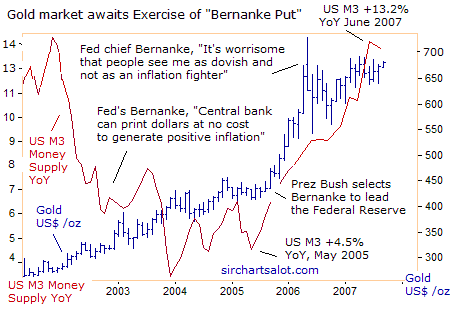
“We conclude that, under a paper-money system, a determined government can always generate higher spending and hence positive inflation,” Bernanke said. In February 2006, Texas Rep Ron Paul asked Bernanke to reconsider publishing the M3 money supply. Bernanke replied the Fed staff had not found M3 as a useful indicator of monetary policy. “Therefore, in order to reduce the reporting costs to financial institutions, the Fed had decided to drop the calculation and publication of M3.”
During his appearance before the world's top central bankers and economic gurus at Jackson Hole, Wyoming on August 31 st , Bernanke dismissed accusations that he is ready to bail out greedy salesman of toxic sub-prime mortgage debt, and their clients who lost money. Justifying future rate cuts, he showed compassion for home flippers and sub-prime owners, “developments in financial markets can have broad economic effects felt by many outside the markets, and the Federal Reserve must take those effects into account when determining policy,” Bernanke said.
Martin Feldstein, chief executive of the National Bureau of Economic Research, called on Mr Bernanke to lower the fed funds by 1% to prevent house price declines or a pullback in consumer spending from causing a recession. “Experience suggests that the dramatic decline in residential construction provides an early warning of a coming recession. The likelihood of a recession is increased by what is happening in credit markets and mortgage borrowing,” he said.
Speaking frankly, Feldstein admitted, “If Fed cuts rates result in higher inflation - it would be the lesser of two evils.” Thus, Americans must prepare for a further dilution of their purchasing power, and the most evil tax of all – higher Inflation. It's also a “moral hazard” if Fed rate cuts inspire more reckless and leveraged speculation in global stock markets.
Is the Yellow metal Shining in Beijing? Gold bugs have been patiently waiting for Beijing to see the light, and begin switching some of its $1.33 trillion FX stash into hard money. China's share of all US Treasury holdings abroad had risen to 18.3% this year, up from 8.6% five years ago. Since then however, the US 10-year T-Note to Gold ratio has collapsed from 100-cents to 42-cents on the dollar today.
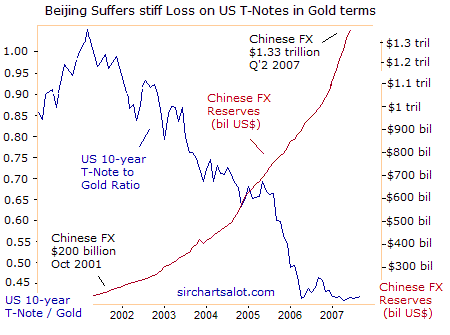
Beijing recycled most if its trade surplus back into US Treasury bonds, in return for a Bush veto against Congressional legislation aimed at its undervalued yuan. But now Beijing sees a “veto proof” protectionist bill sailing thru the US Congress later this year, and has been a net seller of US T-bonds for three straight months by a record amount of $14.7 billion, the longest period of sales by China since November 2000.
Gold demand is rising in the Persian Gulf
With black gold trading above $70 per barrel again, Saudi Arabia boosted its purchases of gold to 42.5 tons in the second quarter of 2007, up from 32.6 tons the year earlier. Gold demand in the United Arab Emirates increased 14.6% to 29.8 tons. Total demand in the Middle East rose 20% to 97.5 tons in the second quarter from a year earlier. The UAE, Saudi Arabia and Kuwait hold $1.55 trillion of foreign asset holdings, dwarfing China's mammoth $1.33 trillion of foreign currency reserves.
Kuwait might be ready to devalue the US dollar, to hold down its inflation rate and control its money supply. Money supply in Kuwait grew at its fastest pace since 1994, with M3 hitting 18 billion dinars ($63.85 billion) at the end of July, up 22.5% from a year earlier, up from 17.7% year-on-year in June.
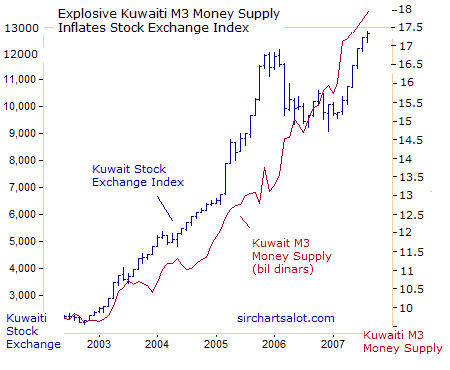
Annual inflation in the Middle East's fourth largest oil exporter topped 5% in May, linked to the Kuwaiti dinar's peg to the US dollar, and slide to record lows against the Euro, which is raising import costs. Kuwait pays for about a third of its imports with the Euro. Massive money supply growth is pumping up the local stock market, and it might encourage Kuwaiti princes to buy gold as an inflation hedge.
Looking forward,
Is gold ready to sustain a powerful rally above $700 /oz, fueled by the exercise of the “Bernanke Put?” What is the major psychological hurdle that gold must overcome, before climbing to higher ground? What's keeping gold down right now? The answers will be revealed in the blockbuster Sept 7 th edition of Global Money Trends, as well as extensive coverage on the global credit crunch, and its likely impact on global stock markets, the US$, crude oil, copper, and other commodities.
Until then, contemplate the following words of wisdom: “At some point, you have to choose between trusting the natural stability of Gold, and the honesty and intelligence of members of the government. With due respect for these gentlemen, I advise you, as long as the capitalist system lasts, to vote for Gold,” said George Bernard Shaw in 1928.
Should you place your faith in Federal Reserve notes? “Money is too important to be left to central bankers. You essentially have a group of unelected people who have enormous power to affect the economy. I've always been in favor of replacing the Fed with a laptop computer, to calculate the monetary base and expand it annually, through war, peace, feast and famine by a predictable 2%,” said Milton Friedman.
By Gary Dorsch,
Editor, Global Money Trends newsletter
http://www.sirchartsalot.com
This article is just the Tip of the Iceberg, of what’s available in the Global Money Trends newsletter! Here's what you will receive with a subscription, Insightful analysis and predictions for the (1) top dozen stock markets around the world, Exchange Traded Funds, and US home-builder indexes (2) Commodities such as crude oil, copper, gold, silver, the DJ Commodity Index, and gold mining and oil company indexes (3) Foreign currencies such as, the Australian dollar, British pound, Euro, Japanese yen, and Canadian dollar (4) Libor interest rates, global bond markets and central bank monetary policies, (5) Central banker "Jawboning" and Intervention techniques that move markets.
GMT filters important news and information into (1) bullet-point, easy to understand analysis, (2) featuring "Inter-Market Technical Analysis" that visually displays the dynamic inter-relationships between foreign currencies, commodities, interest rates and the stock markets from a dozen key countries around the world. Also included are (3) charts of key economic statistics of foreign countries that move markets.
A subscription to Global Money Trends is offered at only $150 US dollars per year for “44 weekly issues”, including access to all back issues. Click on the following hyperlink, to order now, http://www.sirchartsalot.com/newsletters.php Call toll free from USA to order, Sunday thru Thursday, 2 am to 4 pm EST, at 866-576-7872.
Mr Dorsch worked on the trading floor of the Chicago Mercantile Exchange for nine years as the chief Financial Futures Analyst for three clearing firms, Oppenheimer Rouse Futures Inc, GH Miller and Company, and a commodity fund at the LNS Financial Group.
As a transactional broker for Charles Schwab's Global Investment Services department, Mr Dorsch handled thousands of customer trades in 45 stock exchanges around the world, including Australia, Canada, Japan, Hong Kong, the Euro zone, London, Toronto, South Africa, Mexico, and New Zealand, and Canadian oil trusts, ADR's and Exchange Traded Funds.
He wrote a weekly newsletter from 2000 thru September 2005 called, "Foreign Currency Trends" for Charles Schwab's Global Investment department, featuring inter-market technical analysis, to understand the dynamic inter-relationships between the foreign exchange, global bond and stock markets, and key industrial commodities.
Copyright © 2005-2007 SirChartsAlot, Inc. All rights reserved.
Disclaimer: SirChartsAlot.com's analysis and insights are based upon data gathered by it from various sources believed to be reliable, complete and accurate. However, no guarantee is made by SirChartsAlot.com as to the reliability, completeness and accuracy of the data so analyzed. SirChartsAlot.com is in the business of gathering information, analyzing it and disseminating the analysis for informational and educational purposes only. SirChartsAlot.com attempts to analyze trends, not make recommendations. All statements and expressions are the opinion of SirChartsAlot.com and are not meant to be investment advice or solicitation or recommendation to establish market positions. Our opinions are subject to change without notice. SirChartsAlot.com strongly advises readers to conduct thorough research relevant to decisions and verify facts from various independent sources.
© 2005-2022 http://www.MarketOracle.co.uk - The Market Oracle is a FREE Daily Financial Markets Analysis & Forecasting online publication.




